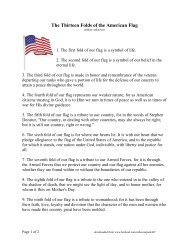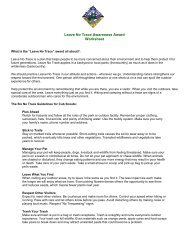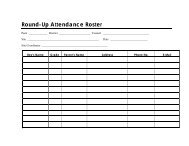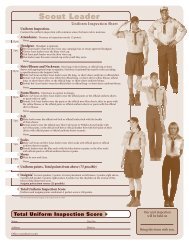BSA Guide To Safe Scouting 34416 - Hot4CAD Online
BSA Guide To Safe Scouting 34416 - Hot4CAD Online
BSA Guide To Safe Scouting 34416 - Hot4CAD Online
- No tags were found...
Create successful ePaper yourself
Turn your PDF publications into a flip-book with our unique Google optimized e-Paper software.
Risk Reduction (when no safe building or vehicle is nearby):• If camping, hiking, etc., far from a safe vehicle or building,avoid open fields, the top of a hill, or a ridge top.• Spread your group out 100 feet from each other if possible.• Stay away from tall, isolated trees; flag poles; totem poles;or other tall objects. If you are in a forest, stay near a lowerstand of trees.• If you are camping in an open area, set up camp in avalley, ravine, or other low area, but avoid flood-prone areas.Remember, a tent offers NO protection from lighting.• Stay away from water, wet items (such as ropes), and metalobjects (such as fences and poles). Water and metal areexcellent conductors of electricity.• If boating and you cannot get back to land to a safe buildingor vehicle: On a small boat, drop anchor and get as lowas possible. Large boats with cabins, especially those withlightning protection systems properly installed, or metalmarine vessels offer a safer but not risk-free environment.Remember to stay inside the cabin and away from anymetal surfaces.If lightning strikes, be prepared to administer CPR(cardiopulmonary resuscitation) so that you can tend tolightning victims quickly (they do not hold an electricalcharge). Take anyone who is a victim of a lightning strike ornear-strike to the nearest medical facility as soon as possible,even if the person appears to be unharmed.For additional information on lightning and weatherservices, visit www.noaa.gov.Treated Drinking WaterA constant supply of treated drinking water is essential.Serious illness can result from drinking untreated water.Protect your health, and don’t take a chance on using waterof uncertain quality. Thermos jugs, plastic water containers,and canteens are all satisfactory for carrying water. Be surewater is dispensed into each person’s own drinking cup.<strong>Safe</strong> Drinking WaterWhen possible, begin your trip with water from home oruse approved portable water sources provided by the landmanager. When these options are not available, streams,rivers, lakes, springs, and snow may provide a source of water,but they must always be treated by one of the followingmethods. All water of uncertain treatment should be treatedbefore use.diameter rise from the bottom of the pot. While this is asimple method, it does require time and fuel.Chemical TreatmentChemical treatment consists of iodine or chlorine tabletsthat kill waterborne bacteria and viruses. These are simple,lightweight, and easy to pack. However, not all protozoaare eliminated by chemical treatment, and a waiting periodis required for effective disinfection of drinking water.Micropur is a new product available for water purification.In all cases, verify that the chosen method of chemicaltreatment meets EPA standards.Liquid chlorine should be used only in an emergency.1. Filter the water to remove as many solids as possible.2. Bring the water to a rolling boil for a full minute.3. Let it cool at least 30 minutes.4. Add eight drops of liquid chlorine bleach per gallon ofcool water. (Use common household bleach; 5.25 percentsodium hypochlorite should be the only active ingredient,and there should not be any added soap or fragrances.)Water must be cool, or chlorine will dissipate and berendered useless.5. Let the water stand 30 minutes.6. If it smells of chlorine, you can use it. If it does notsmell of chlorine, add eight more drops of bleach andlet it stand another 30 minutes. Smell it again. You canuse it if it smells of chlorine. If it doesn’t, discard it andfind another water source.7. The only accepted measurement of chlorine (or watertreatment agents) is the drop. A drop is specificallymeasurable. Other measures such as “capful” or “scantteaspoon” are not uniformly measurable and shouldnot be used.FiltersPortable filters are handheld pumps that force untreatedwater through a filter media that traps bacteria and protozoa.Many include a purifying stage that will also treat viruses.While very effective, filters must be maintained according tothe manufacturer’s instructions, and they are difficult to usewith groups because of the time required to operate.In addition to having a bad odor or taste, water fromquestionable sources may be contaminated by microorganisms,such as Giardia, that can cause a variety of diseases.BoilingThe surest means of making your drinking water safeis to heat it to a rolling boil—when bubbles a half inch in18The online version of the <strong>Guide</strong> to <strong>Safe</strong> <strong>Scouting</strong> is updated quarterly.Go to http://www.scouting.org/Healthand<strong>Safe</strong>ty/GSS.aspx.








